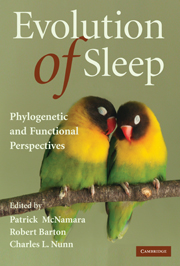Book contents
- Frontmatter
- Contents
- Contributors
- Acknowledgments
- Introduction
- 1 Ecological constraints on mammalian sleep architecture
- 2 Sleep in insects
- 3 Schooling by continuously active fishes: Clues to sleep's ultimate function
- 4 What exactly is it that sleeps? The evolution, regulation, and organization of an emergent network property
- 5 Evolutionary medicine of sleep disorders: Toward a science of sleep duration
- 6 Primate sleep in phylogenetic perspective
- 7 A bird's-eye view of the function of sleep
- 8 The evolution of wakefulness: From reptiles to mammals
- 9 The evolution of REM sleep
- 10 Toward an understanding of the function of sleep: New insights from mouse genetics
- 11 Fishing for sleep
- Index
- Plate section
- References
8 - The evolution of wakefulness: From reptiles to mammals
Published online by Cambridge University Press: 10 March 2010
- Frontmatter
- Contents
- Contributors
- Acknowledgments
- Introduction
- 1 Ecological constraints on mammalian sleep architecture
- 2 Sleep in insects
- 3 Schooling by continuously active fishes: Clues to sleep's ultimate function
- 4 What exactly is it that sleeps? The evolution, regulation, and organization of an emergent network property
- 5 Evolutionary medicine of sleep disorders: Toward a science of sleep duration
- 6 Primate sleep in phylogenetic perspective
- 7 A bird's-eye view of the function of sleep
- 8 The evolution of wakefulness: From reptiles to mammals
- 9 The evolution of REM sleep
- 10 Toward an understanding of the function of sleep: New insights from mouse genetics
- 11 Fishing for sleep
- Index
- Plate section
- References
Summary
Introduction
The evolution of sleep has been the subject of several studies and reviews (Allison & Cicchetti, 1976; Allison & Van Twyver, 1970; Hartse, 1994; Karmanova, 1982; Meddis, 1983; Monnier, 1980; Tauber, 1974). However, corresponding studies on the evolution of wakefulness have been fewer (Esteban, Nicolau, Gamundí, et al., 2005; Nicolau, Akaârir, Gamundí, et al., 2000), despite a number of reasons supporting the greater importance of waking in animal adaptation. First of all, waking and sleep are inseparable, an obvious assertion that, notwithstanding, has been ignored in most reviews (see, for instance, Zepelin, 1994; Zepelin & Rechtschaffen, 1974; Zepelin, Siegel, & Tobler, 2005). These reviews compute correlations between the main traits of sleep and ecological variables while forgetting that high correlations of a given trait with total sleep time also imply high correlations with waking time. The present review proposes a change of paradigm from sleep centeredness to waking centeredness.
Let us give an example of the paradigm change: there might be two possible viewpoints related to the high danger of a particular species' exposure within an environment, namely:
Sleep is a dangerous state. Therefore natural selection must have reduced sleep in dangerous environments.
Alertness is necessary to cope with danger. Therefore natural selection must have increased waking time in dangerous environments.
The difference between the two alternatives might seem subtle: but the former focuses on sleep as a key adaptive factor, while the latter is waking-centered.
- Type
- Chapter
- Information
- Evolution of SleepPhylogenetic and Functional Perspectives, pp. 172 - 196Publisher: Cambridge University PressPrint publication year: 2009
References
- 1
- Cited by



